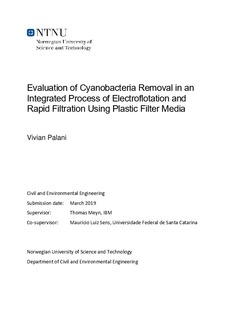| dc.description.abstract | Cyanobakterier er en av jordens eldste oksygenproduserende organismer og finnes i en rekke vann. Hovedproblemet forbundet med cyanobakterier er deres evne til å frigjøre cyanotoksiner som kan forårsake skader på leveren, det nevromuskulære systemet og huden. I vannbehandlingsanlegget i nærheten av innsjøen Peri i Florianopolis (Brasil) forårsaker høye cyanobakterienivåer høye energibehov grunnet ofte nødvendig filterspyling, noe som resulterer i høy slamproduksjon. I tillegg er det fare for at cyanotoksiner slippes ut og ender opp i vanndistribusjonssystemet. Siden cyanobakterier ofte er lette, er flotasjonsteknologier en god erstatning for sedimenteringsbassenger. Innen flotasjonsteknologier har elektroflotasjon (EF) vist seg å være et lovende alternativ på grunn av enkel drift og evne til å generere små bobler. I denne studien ble et pilotanlegg med et integrert system med elektroflotering ved hjelp av dimensjonelt stabile anoder (DSA®) etterfulgt av filtrering med polyvinylklorid (PVC) kuler som filter materiale brukt til å evaluere ytelsen ved fjerning av cyanobakterier fra vannet fra innsjøen Peri. Pilotens ytelse på fjerning av turbiditet og farge ble også evaluert. Forskjellige elektriske strømtettheter ble brukt til å identifisere optimal fjerningsgrad. NaCl ble brukt til å forbedre konduktiviteten av råvannet. For den høyeste strømtettheten som ble påført, ble polariteten invertert for å unngå ytterligere korrosjon av DSA®-ene. Resultatene ga høyest reduksjon av cyanobakterier på 92,3% med en strømtetthet på 89,2 A / m² etter EF. Med hensyn til fjerning av cyanobakterier bidro ikke filtrering betydelig. Maksimal reduksjon av cyanobakterier etter den integrerte prosessen var på 96,7%. Korrosjon på DSA® ble påvist å ha stor innvirkning på resultatene, blant annet ved å økte turbiditeten og delvis påvirke flotasjonsytelsen. Turbiditeten økte mindre da polariteten var invertert og store mengder klor ble generert. Filteret fjernet opptil 76,4% av turbiditeten i forhold til verdiene etter EF. Imidlertid fjernet den integrerte prosessen som helhet ikke en signifikant stor mengde turbiditet, da den høyeste reduksjonen var på 52%. Selv om EF ble påvist å være effektivt ved fjerning av cyanobakterier, er turbiditetsøkningen, som antas å være forårsaket av korrosjonen, avgjørende da cyanobakteriene kan knytte seg til partiklene. Når det gjelder PVC-kuler som brukes som filter materiale, resulterte behovet for lang filterspylingstid i en ikke-kostnadseffektiv løsning. | |
| dc.description.abstract | Cyanobacteria is one of the Earths oldest oxygen-producing organisms and can be found in a variety of water bodies. The main problem associated with cyanobacteria is their ability to release cyanotoxins that may cause damages to the liver, the neuromuscular system and the skin. In the water treatment plant located near Lake Peri in Florianopolis (Brazil), high cyanobacteria levels are causing high energy demands due to frequently required backwashing, resulting in high sludge production. In addition, there is a risk of cyanotoxins being released and ending up in the water distribution system. As cyanobacteria are often light, flotation technologies are a good substitute for sedimentation basins. Within flotation technologies, electroflotation (EF) has proved to be a promising alternative due to simplicity of operation and its ability to generate small bubbles. In this study, a pilot plant with an integrated system of electroflotation using dimensionally stable anodes (DSA®) followed by rapid filtration with polyvinyl chloride (PVC) spheres as filter media was used to evaluate the performance on cyanobacteria removal from the water of Lake Peri. Its’ performance on turbidity and colour removal was also evaluated. Different electrical current densities were used to identify the optimal removal rate. NaCl was used to improve the electrical conductivity of raw water. For the highest current density applied, the polarity was inverted to avoid further corrosion on the DSA®s. The results gave the highest cyanobacteria removal rate of 92,3% at a current density of 89,2 A/m² after EF. With regards to cyanobacteria removal, the filtration step did not contribute significantly. The maximal cyanobacteria removal rate after the integrated process was 96,7%. Corrosion on the DSA® was shown to have a large impact on the results, among other effects, it increased the turbidity and partly affected the flotation performance. The turbidity increased less during polarity inversion and high amounts of chlorine was generated. The filter removed up to 76,4% of the turbidity relative to the values after EF. However, the integrated process as a whole did not remove a significantly large amount of turbidity, the highest removal rate being 52%. Although EF was shown to be efficient in the removal of cyanobacteria, the turbidity increase, thought to be caused by the corrosion, is crucial as the cyanobacteria can be retained in the particles. Regarding PVC spheres used as filter media, the need for long backwash duration resulted in a non-cost-effective solution. | |
